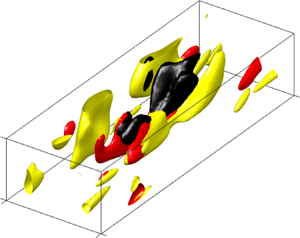Article contents
Minimal multi-scale dynamics of near-wall turbulence
Published online by Cambridge University Press: 26 February 2021
Abstract

Recent numerical experiments have shown that the temporal dynamics of isolated energy-containing eddies in the hierarchy of wall-bounded turbulence are governed by the self-sustaining process (SSP). However, high-Reynolds-number turbulence is a multi-scale phenomenon and exhibits interaction between the structures of different scales, but the dynamics of such multi-scale flows are poorly understood. In this study, the temporal dynamics of near-wall turbulent flow with two integral length scales of motion are investigated using a shear stress-driven flow model (Doohan et al., J. Fluid Mech., vol. 874, 2019, pp. 606–638), with a focus on identifying scale interaction processes through the governing equations and relating these to the SSPs at each scale. It is observed that the dynamics of the energy cascade from large to small scales is entirely determined by the large-scale SSP and the timing of the corresponding inter-scale turbulent transport coincides with the large-scale streak breakdown stage. Furthermore, the characteristic time scales of the resulting small-scale dissipation match those of the large-scale SSP, indicative of non-equilibrium turbulent dissipation dynamics. A new scale interaction process is identified, namely that the transfer of wall-normal energy from large to small scales drives small-scale turbulent production via the Orr mechanism. While the main outcome of this driving process appears to be the transient amplification of localised small-scale velocity structures and their subsequent dissipation, it also has an energising effect on the small-scale SSP. Finally, the feeding of energy from small to large scales is impelled by the small-scale SSP and coincides with the small-scale streak instability stage. The streamwise feeding process seems to be related to the subharmonic sinuous streak instability mode in particular and leads to the formation of the wall-reaching part of high-speed large-scale streaks.
JFM classification
Information
- Type
- JFM Papers
- Information
- Copyright
- © The Author(s), 2021. Published by Cambridge University Press
References
REFERENCES
- 24
- Cited by


